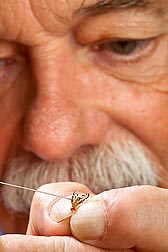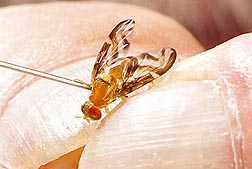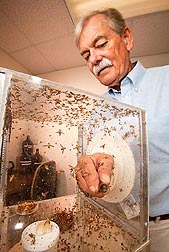Making Fruit Flies More Macho for Sterile Insect Releases
|
|
The Mexican fruit fly, Anastrepha ludens, is considered a significant quarantine pest that could cause billions of dollars in losses to citrus, peach, pears, avocado, and other crops were it to move into the United States from Mexico.
Fortunately, Mexico, in cooperation with the U.S. Department of Agriculture’s Animal and Plant Health Inspection Service, has an aggressive program in place to counter the threat posed by the green-eyed, 1-centimeter-long fly. The program’s ultimate target, though, is not the adult insect, but rather its larval stage, during which it feeds inside the fruit of host crops, rendering them unfit for consumption or sale.
At the heart of Mexico’s anti-fly program is the sterile insect technique (SIT), which involves sterilizing millions of male fruit flies with irradiation and releasing them en masse to mate with wild female flies. Such matings result in nonviable eggs that fail to hatch. Over time, repeated releases of sterile male flies cause the targeted pest population to collapse, diminishing or eliminating the need for insecticide spraying.
Now, a new advance promises to improve the SIT program’s effectiveness and save on operational costs associated with rearing the flies. An international team of scientists from the Agricultural Research Service and other organizations has shown that an analogue of the insect hormone methoprene can be used to speed up the rate at which male flies reach sexual maturity. This means that the flies are ready for release sooner than the standard 7 to 9 days.
|
|
“In every case, we more than halved the time it took the flies to sexually mature. We could release them at 4 days old,” says Peter Teal, a principal investigator on the team and the research leader in ARS’s Chemistry Research Unit in Gainesville, Florida.
What’s more, the methoprene treatment “makes the flies more macho,” says Teal, whose collaborators included researchers in Mexico, Argentina, and Austria. Compared to the untreated males, methoprene-treated flies produce more pheromone and attract more females to mate with than do flies that are just irradiated.
In addition to studying methoprene’s effects on Mexican, Caribbean, and other tephritid fruit flies, as well as nutritional requirements for the species’ pheromone signaling and reproductive success, the team devised large-scale methods of treating the insects. These methods included development of an adult diet, in the form of a paste, which contains methoprene and costs only $13 per 1 million released flies.
Other research by the team involves adding amino acids from hydrolyzed protein to the fruit fly diet, which makes them more robust and better able to escape predators when released into the wild. Most importantly, “they mate better with feral female flies,” adds Teal.
In laboratory trials, sterile male flies fed a diet containing 0.05 percent or 0.1 percent of methoprene and hydrolyzed protein were ready to mate 4 to 5 days sooner than untreated males and produced more pheromone, to boot. Outdoor trials were also successful.
Use of methoprene or hydrolyzed protein alone did not work as well as when the two were combined, and not all species responded to the treatment—Mediterranean and Oriental fruit flies being two.
Nevertheless, “the methods to incorporate these technologies into mass rearing of sterile flies and the technique are now in use for control of the Mexican fruit fly in Mexico,” notes Teal, who coauthored a paper in the April 2011 issue of Journal of Applied Entomology.
Data collected from SIT-treated areas of Rio Verde by the Mexican National Campaign Against Fruit Flies indicates that the population of A. ludens flies there has been reduced to below 0.01 fly per trap per day.—By Jan Suszkiw, Agricultural Research Service Information Staff.
This research is part of Crop Protection and Quarantine (#304), an ARS national program described at www.nps.ars.usda.gov.
Peter Teal is in the USDA-ARS Chemistry Research Unit, Center for Medical, Agricultural, and Veterinary Entomology, 1600-1700 S.W. 23rd Dr., Gainesville, FL 32608; (352) 374-5730.
"Making Fruit Flies More Macho for Sterile Insect Releases" was published in the September 2012 issue of Agricultural Research magazine.









